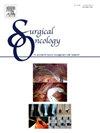Life after oncoplastic surgery (IRONY) trial: Preliminary results
IF 2.4
4区 医学
Q3 ONCOLOGY
引用次数: 0
Abstract
Background
Today partial reconstruction in breast cancer (BC) surgery involves displacement or replacement procedures to improve cosmesis without compromising safety. However, patient satisfaction should be compared among several options, in order to get additional criteria for a personalized approach. The aim is evaluate oncological, aesthetic and functional results after monolateral (reshaping or replacement) or bilateral (mammoplasty with contralateral pexy or reduction) conserving strategies.
Materials and methods
The protocol provides for the enrollment of a prospective sample of 250 patients in a time frame of 3 years. The first 108 cases (range 18–85 years) with BC diagnosis, and suitable for type 1–2 oncoplastic surgery who gave informed consent, were selected Data analysis was focused on radicality, complications, cosmetic and functional results related to quality of life, comparing monolateral (ML) and bilateral (BL) groups.
Results
Tumor size (p = 0.01), multifocality (p = 0.05), multicentricity (p = 0.01) and estimated resection volume (p = 0.000) were higher in the BL group. There was a comparable re-excision rate for positive margins (p = 0.72), and after 2.3 years, no difference in local recurrences were recorded. No early (p > 0.05), but late complications were more common in the BL (p = 0.07). The overall satisfaction with cosmesis and well-being were characterized by similar proportions of good results (p>0.05), with some details more related to each procedure.
Conclusion
The proposed techniques represent effective solutions for reshaping that follows BC excision, achieving comparable early complications, low re-interventions with good aesthetic results and social functioning. However, is crucial a careful patient selection and surgical plan while predicting any sequel or delayed complication during follow-up.
肿瘤整形手术后生活(IRONY)试验:初步结果
目前,乳腺癌(BC)手术中的部分重建包括置换或置换手术,以在不影响安全性的情况下改善美观。然而,患者满意度应该在几个选项之间进行比较,以便获得个性化方法的额外标准。目的是评估单侧(重塑或置换)或双侧(对侧乳房成形或复位)保存策略后的肿瘤学,美学和功能结果。材料和方法该方案规定在3年的时间框架内纳入250例患者的前瞻性样本。选择前108例(18-85岁)确诊为BC,并同意进行1-2型肿瘤整形手术的患者(范围18-85岁)。数据分析的重点是根治性、并发症、与生活质量相关的美容和功能结果,比较单侧(ML)组和双侧(BL)组。结果BL组肿瘤大小(p = 0.01)、多灶性(p = 0.05)、多中心性(p = 0.01)和估计切除体积(p = 0.000)均高于BL组。阳性切缘的再切除率相当(p = 0.72), 2.3年后,局部复发没有记录差异。不早(p >;0.05),但晚期并发症在BL中更为常见(p = 0.07)。对美容和健康的总体满意度的特征是良好结果的比例相似(p>0.05),与每个程序相关的一些细节更多。结论所提出的技术是BC切除术后整形的有效解决方案,具有相似的早期并发症,低再干预率,良好的美学效果和社会功能。然而,在随访期间预测任何后续或延迟并发症时,谨慎的患者选择和手术计划是至关重要的。
本文章由计算机程序翻译,如有差异,请以英文原文为准。
求助全文
约1分钟内获得全文
求助全文
来源期刊

Surgical Oncology-Oxford
医学-外科
CiteScore
4.50
自引率
0.00%
发文量
169
审稿时长
38 days
期刊介绍:
Surgical Oncology is a peer reviewed journal publishing review articles that contribute to the advancement of knowledge in surgical oncology and related fields of interest. Articles represent a spectrum of current technology in oncology research as well as those concerning clinical trials, surgical technique, methods of investigation and patient evaluation. Surgical Oncology publishes comprehensive Reviews that examine individual topics in considerable detail, in addition to editorials and commentaries which focus on selected papers. The journal also publishes special issues which explore topics of interest to surgical oncologists in great detail - outlining recent advancements and providing readers with the most up to date information.
 求助内容:
求助内容: 应助结果提醒方式:
应助结果提醒方式:


